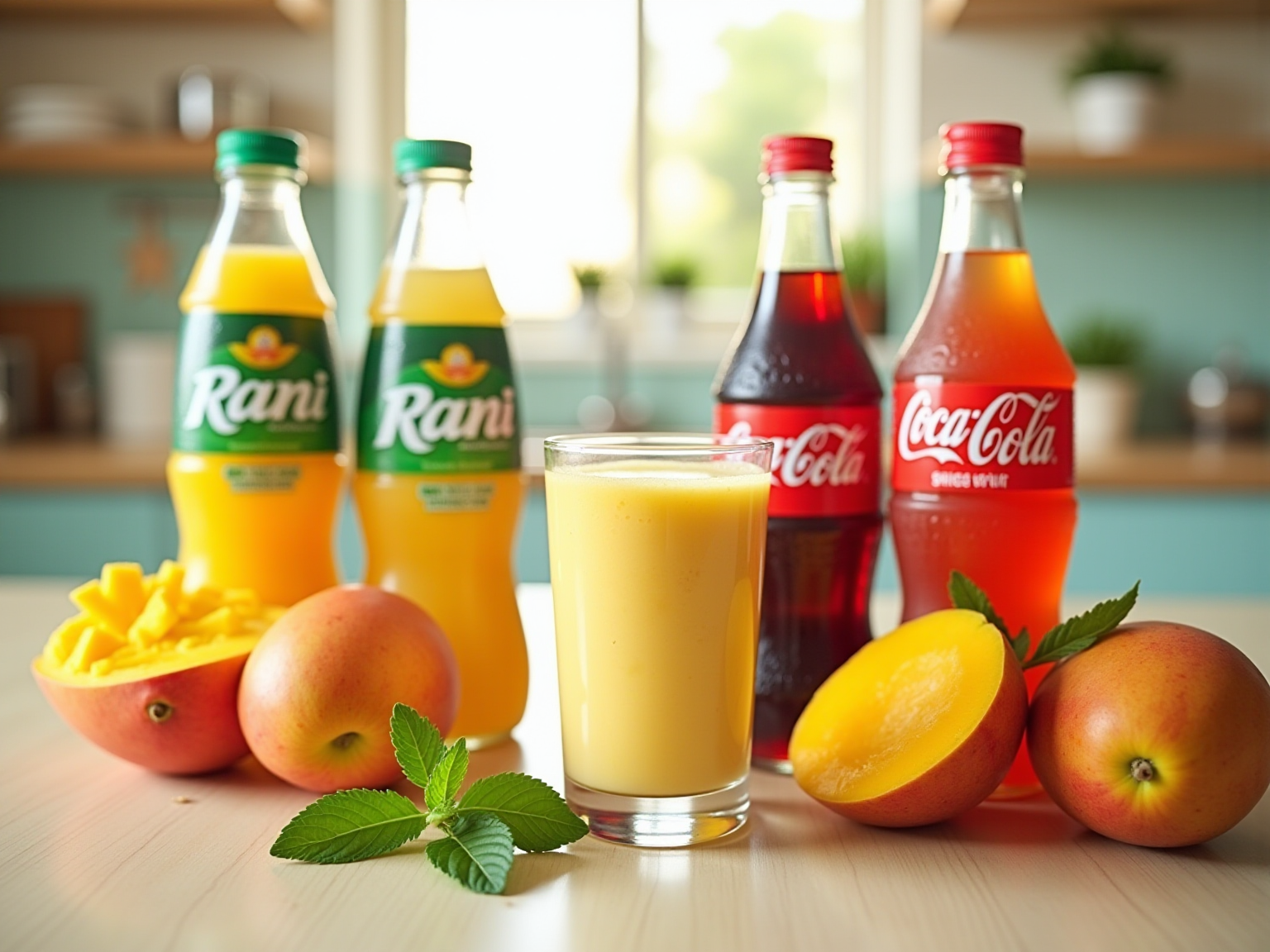General
5 Stages of Design in the UAE Food Industry for Brand Success
Overview
The five stages of design in the UAE food industry for brand success are critical:
- Conducting market research
- Creating a distinct brand identity
- Designing product packaging
- Ensuring compliance with local regulations
- Implementing effective marketing strategies
Understanding consumer demographics is paramount; leveraging emotional branding can significantly enhance engagement. Additionally, emphasizing sustainability in packaging not only meets consumer expectations but also aligns with regulatory standards. Adhering to food safety regulations is non-negotiable, and utilizing digital platforms for marketing is essential to effectively engage with the target audience. In a competitive market, these strategies differentiate brands and drive success.
Introduction
In the dynamic landscape of the UAE food industry, brands are navigating a complex web of consumer preferences, regulatory requirements, and competitive pressures. To thrive, businesses must embark on a multifaceted journey that begins with in-depth market research and culminates in compelling marketing strategies.
Understanding the evolving demographics—particularly the influence of millennials and Gen Z—is essential for crafting a brand identity that resonates. As sustainability becomes a central theme in consumer choices, companies must innovate their packaging and presentation to meet these expectations.
Moreover, compliance with local regulations is not just a necessity but a strategic advantage that fosters consumer trust. This article delves into the critical steps for establishing a successful food brand in the UAE, offering insights on everything from market analysis to effective launch strategies.
Conduct Market Research and Analysis
- Identify target demographics by analyzing age, lifestyle, and purchasing behaviors. Recent trends indicate that millennials are increasingly influential, with 30% of respondents planning to subscribe to food services in the next six months. This statistic highlights their pivotal role in shaping market dynamics. Furthermore, McKinsey underscores that Gen Zers and millennials engage in purchasing on social media four times more frequently than older generations, further emphasizing their significant influence on consumer behavior.
- Conduct a thorough competitor analysis to pinpoint strengths and weaknesses. Understanding competitors’ offerings can reveal market gaps and opportunities for differentiation. For instance, WonderEight’s partnership with Quaker Oats to create a strategic marketing plan exemplifies how examining competitors can enhance market positioning and improve customer engagement.
- Utilize surveys and focus groups to gather direct feedback from clients. Engaging with potential clients allows companies to refine their products according to genuine preferences and expectations.
- Investigate market trends specific to the UAE food sector, focusing on the five stages of design within the UAE food industry, dietary choices, and innovative food technologies. While the Global Consumer Insights Survey indicates a significant shift towards digitalization, concentrating on food sector-specific statistics is crucial to maintaining relevance in this context.
- Compile data into actionable insights that inform branding strategies. This process ensures that marketing initiatives align with customer requirements and market conditions, ultimately propelling product success.
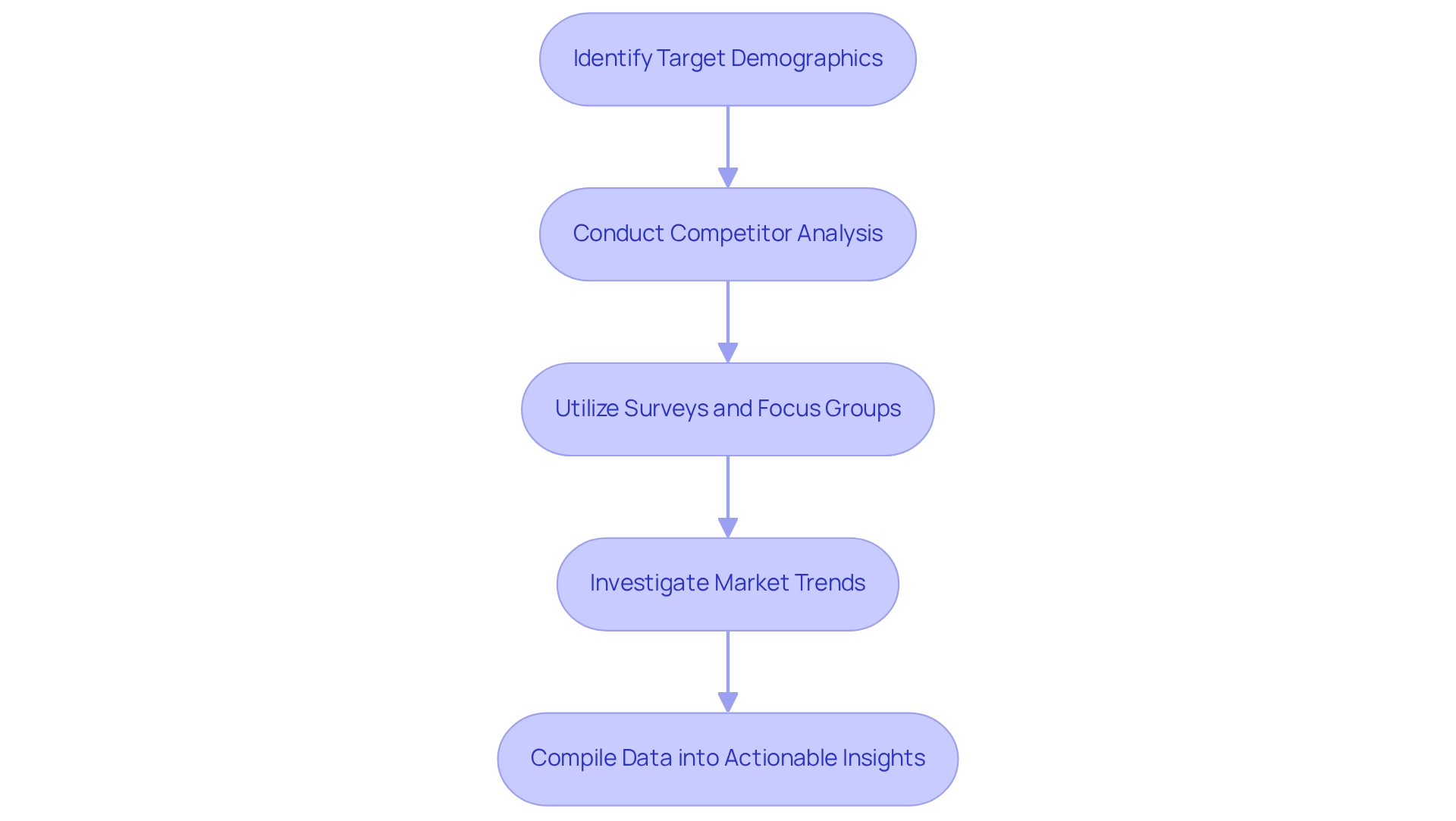
Create a Distinct Brand Identity
- Clearly define your organization’s mission, vision, and values to establish a strong foundation. This clarity not only directs internal decision-making but also connects with individuals seeking authenticity in products. WonderEight’s identity assessment services can assist you in expressing these components effectively.
- Create a captivating narrative that establishes an emotional bond with clients. Emotional branding is particularly effective in the UAE, where 41% of consumers report being influenced by social media. Storytelling becomes a vital tool for engagement in this context. WonderEight’s proficiency in digital marketing strategy, including social media management, can enhance your storytelling initiatives, ensuring they connect and resonate with your target audience.
- Develop a unique visual identity that encompasses your logo, color palette, and typography, reflecting your identity’s personality. This visual depiction should align with your narrative and attract your intended audience. A strong visual identity is essential for food companies in the UAE, especially during the five stages of design in the UAE food industry, as it aids in distinguishing them in a competitive market. WonderEight’s packaging and collateral design services can assist in crafting this identity.
- Ensure consistency across all branding materials, including packaging, marketing collateral, and digital presence. A cohesive identity reinforces recognition and trust among consumers, which is essential in the competitive landscape involving the five stages of design in the UAE food industry. WonderEight’s comprehensive branding solutions, including events and activations, ensure that your identity maintains a unified presence across all platforms.
- Test your identity with focus groups to gather feedback and make necessary adjustments. This ongoing feedback process helps refine your approach and ensures that your branding resonates effectively with your audience. Furthermore, consider incorporating sustainability into your marketing efforts, as emphasized in the case study ‘Sustainability as a Competitive Advantage,’ which demonstrates that companies effectively conveying their sustainability initiatives can improve their market position. WonderEight’s consultancy services can assist you in this area, ensuring your brand not only stands out but also aligns with contemporary values.
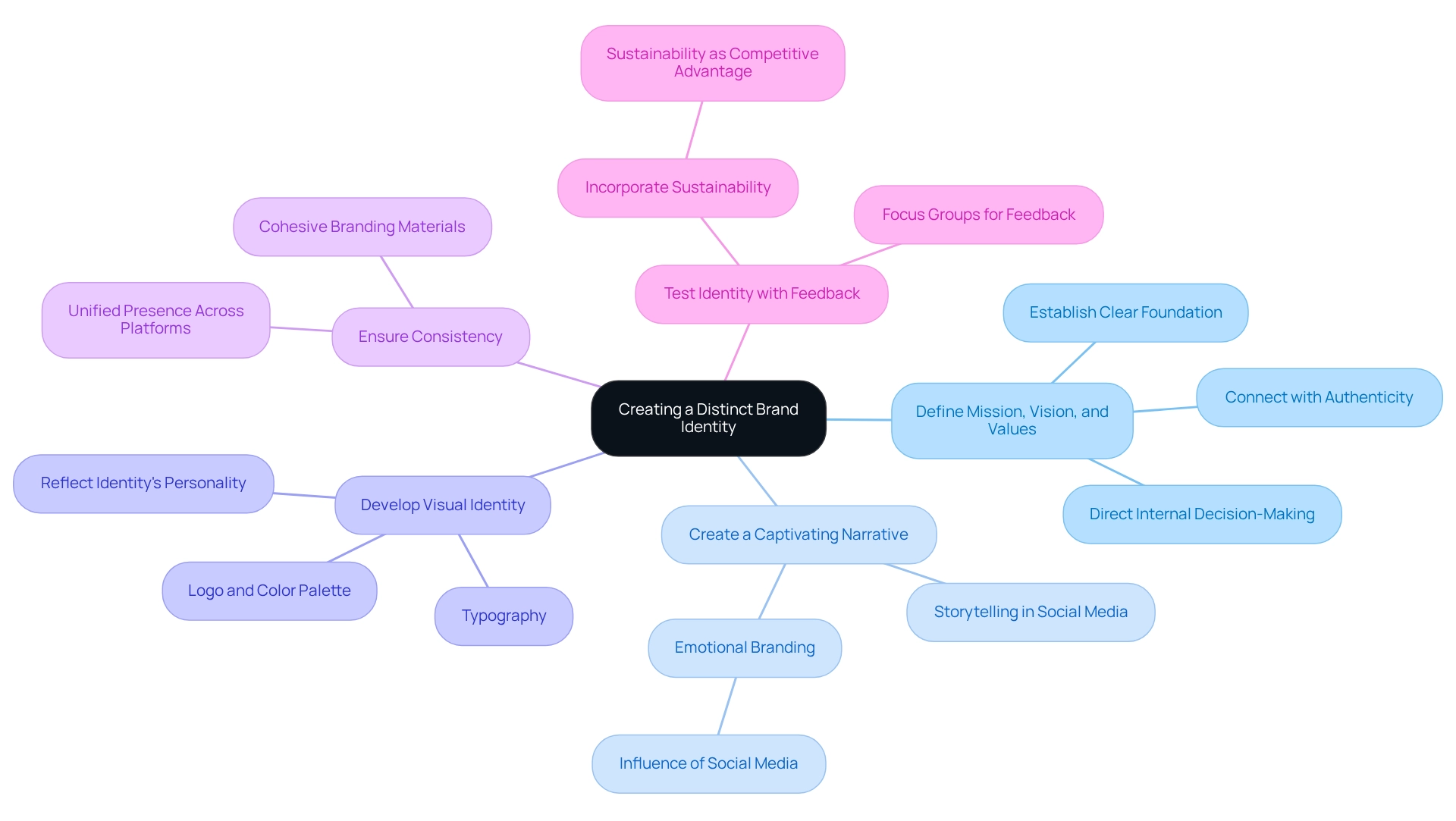
Design Product Packaging and Presentation
Conduct extensive research on container trends in the UAE food sector, emphasizing sustainability and evolving buyer preferences. The UAE market increasingly favors eco-friendly solutions, evidenced by a notable rise in demand for recyclable and biodegradable materials. By 2025, sustainable materials are projected to play a crucial role in attracting environmentally conscious consumers, reflecting a broader global shift towards sustainability. For instance, Coca-Cola conducted its initial trial with 2,000 paper bottles made from a highly durable paper exterior in February 2021, underscoring the sector’s shift towards innovative container solutions.
Create containers that are not only aesthetically pleasing but also seamlessly align with your brand identity. Effective wrapping should resonate with the target audience while embodying the brand’s core values. Integrating local cultural aspects enhances significance and fosters deeper engagement with customers.
Ensure that the container conveys essential product details clearly, including ingredients, nutritional facts, and any certifications related to sustainability. Clarity in labeling is increasingly significant to consumers, who are more informed and concerned about their dietary choices.
Consider cultural factors in design to ensure relevance to the local market. Understanding the cultural nuances and preferences of UAE consumers can significantly influence the effectiveness of presentation and brand image.
Test presentation prototypes with target buyers to gather feedback on design and functionality. Engaging with users during the development stage provides valuable insights, enabling modifications that enhance usability and appeal. This iterative process can lead to more successful product launches and increased consumer satisfaction.
Stay informed about the five stages of design in the UAE food industry to grasp the latest container trends for 2025. Innovations such as Coca-Cola’s exploration of paper bottles highlight the industry’s shift towards sustainable materials. Additionally, Starbucks has invested $10 million into the NextGen Consortium, showcasing the industry’s commitment to sustainability and innovation. Case studies on environmentally friendly materials illustrate how brands can reduce waste and attract customers who prioritize sustainability. For instance, the article on Eco-Friendly Materials and Waste Reduction emphasizes the importance of eco-friendly solutions in minimizing fast-food waste and highlights the benefits of recyclable, recycled, biodegradable, and compostable options. Such solutions can decrease landfill waste, promote sustainability, attract environmentally aware customers, and potentially lower costs associated with plastic taxes. By embracing these trends, companies can position themselves as market leaders while fulfilling customer needs through the five stages of design in the UAE food industry.

Ensure Compliance with Local Regulations
- Comprehend the UAE’s food safety regulations and labeling requirements, which are essential for market entry and public trust.
- Ensure all packaging features essential information in both Arabic and English, including ingredients, expiration dates, and nutritional facts, to cater to the diverse population.
- Secure necessary certifications and approvals from local health authorities to comply with the stringent regulations set forth by the UAE government, including adherence to the Delaney Clause, which prohibits the approval of an additive if it is found to induce cancer when ingested.
- Stay updated on regulatory changes, particularly with the anticipated updates in 2025, to maintain compliance and avoid penalties.
- Implement a robust system for tracking compliance, which is vital for identifying potential violations and ensuring adherence to evolving standards.
- Utilize successful case studies, such as the comprehensive campaign for Quaker Oats, which demonstrates the effectiveness of strategic compliance in enhancing loyalty and awareness among shoppers. This approach not only fulfills regulatory requirements but also enhances company identity in a competitive market. As emphasized by industry specialists, “In the changing food safety environment, utilizing data sharing is crucial to guarantee strong safety practices, transparency, and public trust.”
- Furthermore, product managers should contemplate participating in the forthcoming 10th Conference on Innovations in Nutrition and Food Science (INFS-2025) on July 14-15 in Vienna, Austria, to remain updated on industry advancements and regulatory modifications.
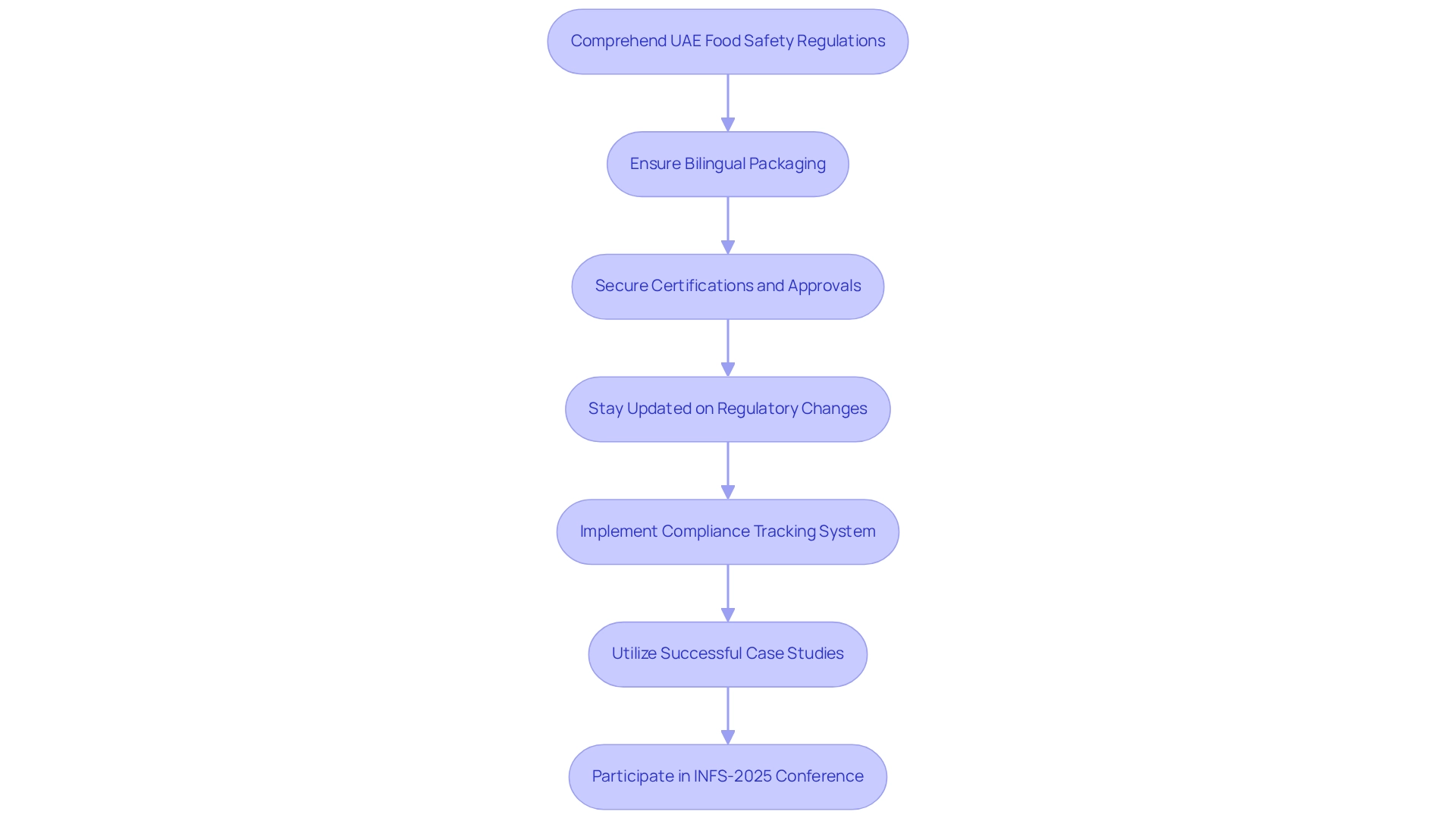
Implement Marketing and Launch Strategies
- Develop a comprehensive marketing plan that integrates both digital and traditional strategies, ensuring a balanced approach to effectively reach diverse consumer segments. Avoid creating segments that are excessively small; consider purchasing power and remain adaptable to market fluctuations.
- Utilize prominent social media platforms in the UAE, such as Instagram and TikTok, to enhance visibility and interaction. These platforms are crucial for connecting with younger audiences and showcasing visually appealing content. For instance, Growthrocks assisted Volta in boosting its traffic by 600%, illustrating the potential impact of effective social media strategies.
- Create engaging content that narrates your company’s story and highlights product advantages. Compelling storytelling can significantly enhance customer connection and loyalty.
- Organize a launch event or promotional campaign to generate excitement around your product. Such events can foster enthusiasm and promote community involvement, thereby boosting initial sales and product awareness.
- Continuously monitor marketing performance through analytics tools, adjusting strategies based on customer feedback and sales data. This iterative approach facilitates real-time enhancements of marketing initiatives, ensuring alignment with market demands.
- Examine successful case studies related to food companies in the UAE to illustrate the importance of the five stages of design in achieving measurable results within the UAE food industry. Insights from industry leaders can provide valuable lessons.
- Stay informed about social media marketing trends within the UAE food industry for 2025, as these trends can inform your content strategy and promotional tactics. Understanding current buyer preferences and behaviors is essential for effective engagement.
- Utilize social media usage statistics in the UAE to inform your marketing strategies, ensuring that your campaigns are data-driven and effectively targeted to reach your desired audience. This information can enhance your approach and improve overall efficiency.
- Create effective digital marketing strategies tailored for the UAE food sector, emphasizing the five stages of design that resonate with local patrons and strengthen brand loyalty. As Kate Hardin emphasizes, aligning marketing efforts with consumer insights is crucial for success.
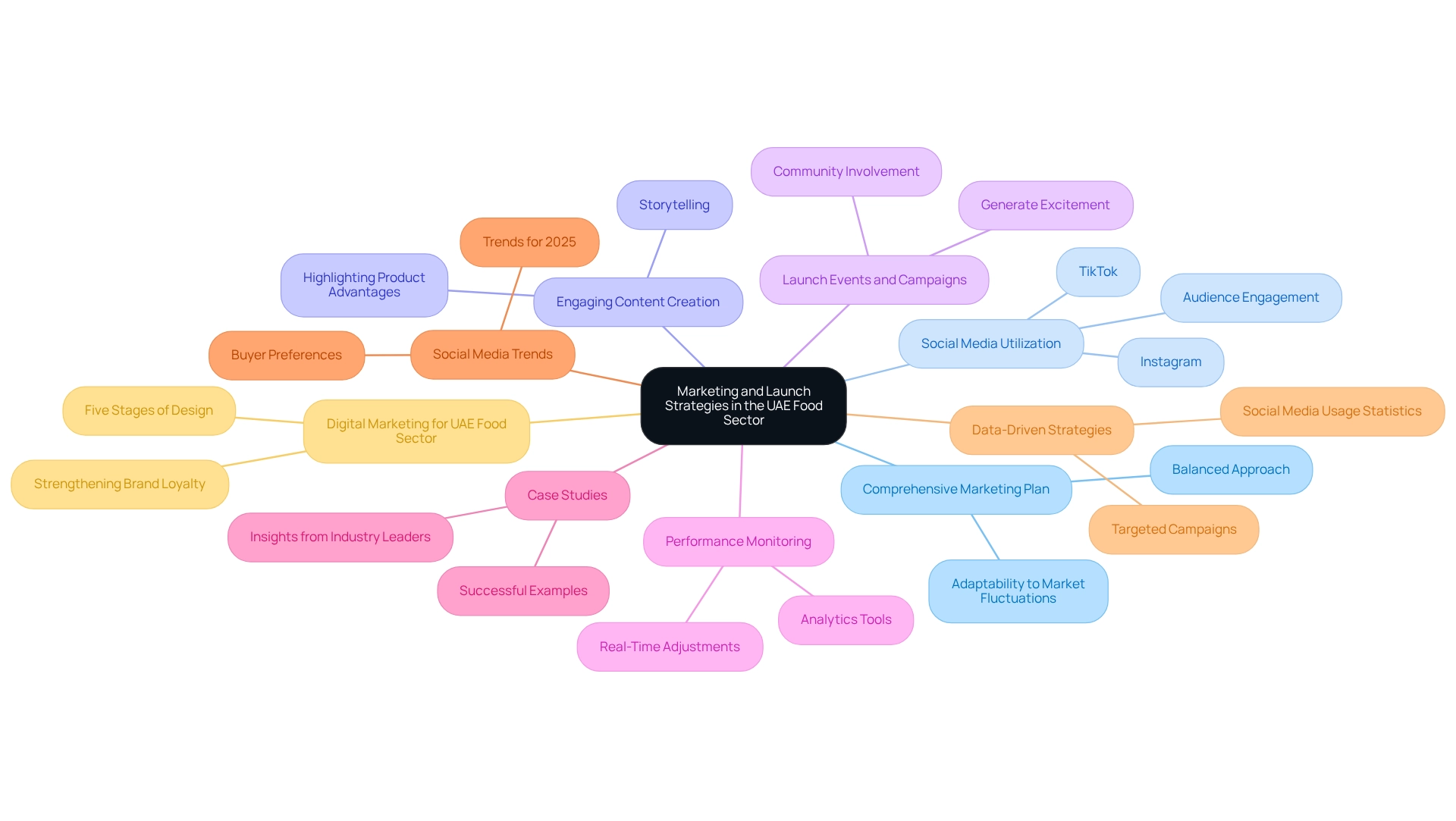
Conclusion
Building a successful food brand in the UAE necessitates a strategic approach that encompasses thorough market research, distinct branding, and effective marketing. Understanding the preferences of influential demographics, particularly millennials and Gen Z, is essential for crafting offerings that resonate deeply.
A robust brand identity, characterized by a clear mission and compelling storytelling, fosters emotional connections with consumers. Consistency in visual branding and the integration of sustainability into packaging not only enhance brand recognition but also align with modern values.
Innovative and eco-friendly packaging plays a critical role in attracting environmentally conscious consumers, while compliance with local regulations builds trust and safeguards against potential challenges. Staying informed about evolving standards is crucial for maintaining market credibility in this dynamic landscape.
Effective marketing strategies, particularly through digital platforms, can significantly boost visibility and engagement. By creating engaging content and continuously monitoring performance, brands can adeptly adapt to consumer demands and enhance their market presence.
In conclusion, a successful food brand in the UAE hinges on a cohesive strategy that includes research, branding, compliance, and marketing. By focusing on these elements, brands can resonate with consumers, foster loyalty, and achieve sustainable growth in this vibrant market. The opportunity to innovate and connect with audiences is now, paving the way for a prosperous future.
Frequently Asked Questions
How can companies identify their target demographics?
Companies can identify their target demographics by analyzing factors such as age, lifestyle, and purchasing behaviors. Recent trends show that millennials are particularly influential, with 30% planning to subscribe to food services in the next six months. Additionally, Gen Zers and millennials engage in purchasing on social media four times more frequently than older generations.
Why is competitor analysis important for businesses?
Conducting a thorough competitor analysis helps businesses pinpoint their strengths and weaknesses. By understanding competitors’ offerings, companies can identify market gaps and opportunities for differentiation, enhancing their market positioning and customer engagement.
What methods can companies use to gather feedback from clients?
Companies can utilize surveys and focus groups to gather direct feedback from clients. Engaging with potential clients allows businesses to refine their products based on genuine preferences and expectations.
What specific market trends should be investigated in the UAE food sector?
In the UAE food sector, companies should focus on the five stages of design, dietary choices, and innovative food technologies. It’s important to concentrate on food sector-specific statistics to maintain relevance, especially given the significant shift towards digitalization highlighted in the Global Consumer Insights Survey.
How can data be transformed into actionable insights for branding strategies?
Companies can compile gathered data into actionable insights that inform their branding strategies. This process ensures that marketing initiatives align with customer requirements and market conditions, ultimately driving product success.
What role does emotional branding play in the UAE market?
Emotional branding is particularly effective in the UAE, where 41% of consumers report being influenced by social media. Creating a captivating narrative helps establish an emotional bond with clients, making storytelling a vital tool for engagement.
How can a unique visual identity benefit a food company?
Developing a unique visual identity, including a logo, color palette, and typography, reflects the company’s personality and attracts the intended audience. A strong visual identity is essential for food companies in the UAE to distinguish themselves in a competitive market.
Why is consistency important in branding materials?
Ensuring consistency across all branding materials, including packaging, marketing collateral, and digital presence, reinforces recognition and trust among consumers. This is crucial in the competitive landscape of the UAE food industry.
How can companies refine their branding identity?
Companies can test their branding identity with focus groups to gather feedback and make necessary adjustments. This ongoing feedback process helps ensure that the branding resonates effectively with the audience.
What is the significance of incorporating sustainability into marketing efforts?
Incorporating sustainability into marketing efforts can improve a company’s market position, as demonstrated in the case study ‘Sustainability as a Competitive Advantage.’ Effectively conveying sustainability initiatives aligns the brand with contemporary values.


